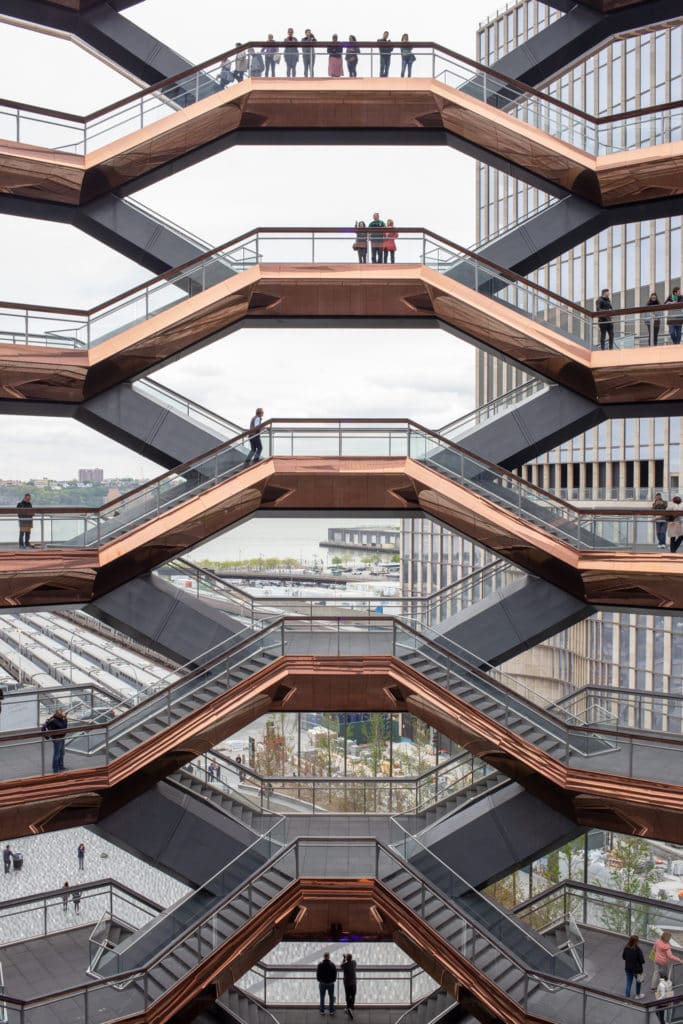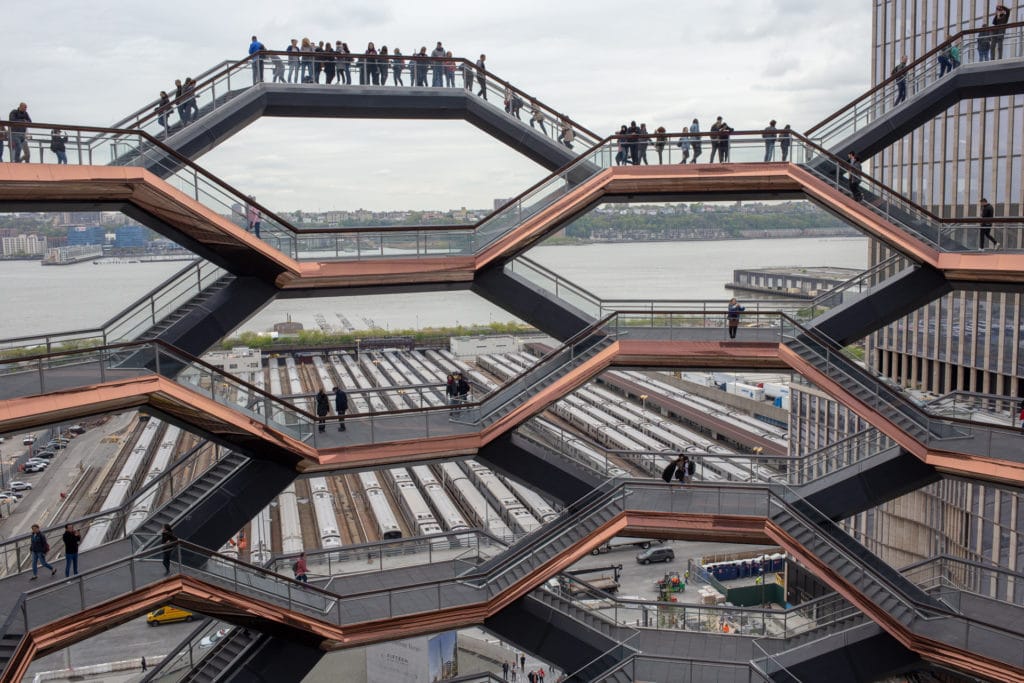New Yorkers are a notoriously tough crowd. When I first heard of the plans to develop the Hudson Yards area into a luxury apartment, dining, and shopping hub, my response was a very visceral ugh. When I think about new developments that could transform New York for the better, a 720,000-square-foot retail center and condos that start at $2 million are not on the list.
The centerpiece of the still in-progress Hudson Yards complex is Vessel. The $150 million interactive art piece, which opened in March, was conceived by Thomas Heatherwick and Heatherwick Studio as a “focal point where people can enjoy new perspectives of the city and one another from different heights, angles, and vantage points.”


“Vessel” is a temporary name, and visitors are encouraged to submit their own ideas for the structure’s permanent name. Surprising no one, the frontrunner on NYC’s subreddit is Staircase McStaircaseface. Other suggestions include Meat Tornado, Chalice of the Privileged, The Rat’s Nest, The Moneycomb, and The Fault In Our Startchitect.
Admission to Vessel is free, but visitors must have a timed ticket, available in advance online or day-of from an on-site kiosk. The structure is being billed as a vertical public park, although it also serves as a literal funnel, dumping exiting visitors dangerously close to the shopping complex.
M.C. Escher meets shawarma meat
I wanted very badly to hate Vessel, and I’m not alone. But the 150-foot-tall, open-air structure charmed me almost immediately. The point of the piece—if there is one—is to climb nearly one mile vertically, using 154 interconnecting flights of stairs, 2,500 individual steps, and 80 landings. There is an elevator that will take you straight to the top if you don’t want, or are unable, to take the stairs—although the real joy is found in the meandering journey to the top.
Photo: Alexandra Charitan Photo: Alexandra Charitan Photo: Alexandra Charitan Photo: Alexandra Charitan Photo: Alexandra Charitan
The ticketed entry might seem like an unnecessary annoyance, but it does help with crowd control. Visitors pile up at the entrance, craning their necks to take in the scale of the structure and snap their first selfies, but otherwise the choose-your-own-adventure staircases and landings evenly distribute people. New York City often seems overwhelmingly choked with people, but my visit to Vessel was surprisingly serene.
In a city full of skyscrapers, we’re so used to looking up and feeling small—Vessel provides an opportunity to do the opposite.
It is nearly impossible to get a photo of Vessel that doesn’t contain other people, but human figures are necessary to convey a sense of scale. In a city full of skyscrapers, we’re so used to looking up and feeling small—Vessel provides an opportunity to do the opposite.
I was pleasantly surprised by the lack of barriers and the relatively short railings: There isn’t a bridge or observation deck in New York that hasn’t been retrofitted with high fences to prevent accidental—or intentional—falls. Peering down from the top inspires vertigo and heart palpitations for anyone with even a mild fear of heights, but I also felt—at the risk of sounding maudlin—free.


It’s human nature to draw comparisons between something new and something familiar—Vessel has been compared to a beehive, a cone of shawarma meat, a pineapple, a trash can, and an M.C. Escher drawing. In a 2016 New York Times article, Heatherwick said his creation was partly inspired by Indian stepwells, but he also compared it to “a climbing frame—what Americans would call a jungle gym” and “a Busby Berkeley musical with a lot of steps.”
“We know ‘Vessel’ will be debated and discussed and looked at from every angle,” New York City Mayor Bill deBlasio said previous to its construction. Addressing Heatherwick directly, he added: “If you meet 100 New Yorkers, you will find 100 different opinions on the beautiful work you’ve created.”
While shawarma may be the most accurate visual comparison, the effect of walking up and down the stairs and across the landings is, I imagine, the closest one can come to actually inhabiting an Escher drawing. I half-expected the staircases to change direction without warning—add a few animated portraits and you’d think you were at a modern, shinier version of Hogwarts.
Photo: Alexandra Charitan Photo: Alexandra Charitan Photo: Alexandra Charitan Photo: Alexandra Charitan
Rob Clarke, who has lived in New York for eight years, visited Vessel on opening weekend. “Overall I give them kudos for doing something different, because it’s certainly that,” he says.
No selfie sticks allowed
Vessel was constructed in Italy and shipped to New York in six separate shipments. The steel frame is covered by a highly-reflective, selfie-friendly, polished copper-colored steel cladding. Although clearly made with Instagram in mind, tripods and selfie sticks are not permitted.
“It’s quite clear this is taking advantage of the ‘Instagram effect,’ and it’s so far very successful at doing so,” says Clarke. “It gives visitors a different background for their selfies or posed photos.”
Vessel is made to be photographed. | Photo: Alexandra Charitan Photo: Alexandra Charitan The reflective cladding is perfect for selfies. | Photo: Alexandra Charitan Photo: Alexandra Charitan
When Vessel first opened, however, the site’s photo policy drew criticism. Hudson Yards’ terms of service—spelled out online but conspicuously absent from the physical structure—stated that the corporation “had the right to use any picture taken in the vicinity of the art installation for commercial purposes, with no royalty fees and no restrictions, forever.”
With so many people snapping photos and tagging locations, it’s not uncommon for privately-owned attractions to use visitors’ photos to promote their businesses. But the Hudson Yards policy went beyond simply asking for the right to share visitor-generated content on their social channels—they were also claiming total ownership of any content created in and around Vessel.
While the Internet—and especially social media—has complicated usage terms and copyright protections, people were still surprised to see such a blatant ownership grab. “They really should have expected the (inevitable) backlash,” says Clarke.
The language has since been revised to make it clear that “the licensing use is exclusively for photos taken in and on the Vessel, so a passerby snapping a photo from 11th Avenue will be exempt from any binding legal restrictions.” People already sacrifice a lot of usage rights just by posting an image to social media, and it remains to be seen whether Vessel’s updated policy is actually enforceable.


After he visited Vessel, Clarke voiced his disagreement with their original photo policy in subsequent Instagram posts. He claims to have altered his photos slightly, adding his own vulgar version of a watermark—a Where’s Waldo?-esque potential PR nightmare for Hudson Yards, should they ever use his photos.
“Whether I photoshopped [male genitalia] into my photos of Vessel on Instagram—in the event of them using them for profit, particularly if they blow them up in size without paying specific attention to detail—is something I will take to my grave,” he says.
Manhattan’s newest neighborhood
Vessel offers (for now) sweeping views of the West Side Yard—a storage yard for Long Island Rail Road trains—the Hudson River, and the Empire State Building. “It’s legitimately impressive as a sculpture,” says Clarke. “But as more buildings go up, the already-limited view at the top will be further restricted.”
A view of the West Side Yard, a storage yard for Long Island Rail Road trains. | Photo: Alexandra Charitan Vessel has a view of the Empire State Building, for now. | Photo: Alexandra Charitan Photo: Alexandra Charitan Photo: Alexandra Charitan Photo: Alexandra Charitan
In the six years that I’ve lived in New York, I’ve mourned the loss of classic diners and countless small businesses, as they get pushed out by unsustainable rent hikes or demolished completely in the name of progress. While the area called Hudson Yards was largely undeveloped—the complex, including Vessel, sits on a platform, constructed above the rail yard—when it’s finished, it will be “the largest mixed-use private real estate venture in American history.” In addition to Vessel, the site will include 16 buildings: residences, a hotel, office buildings, a mall, a school, and a cultural facility.
“Without trying to sound jaded given my short time here—I’m still a tourist in my eyes—the city doesn’t need more white-washed glass towers,” says Clarke. “Certainly not at the expense of the things around the city that have character and intrigue.”
Vessel sits close to the northern entrance to the High Line, another elevated public park that is a rousing success—or a tourist-packed nightmare, depending on who you ask.
“The city is already an incredibly expensive place to live,” says Clarke. “A lot of these developments just seem to raise rents on small businesses, and that drives them out. The city should be a hotbed of new ideas and concepts, and these things seem to be few and far between lately.”
If you go
Vessel is closed indefinitely pending a safety review.
























